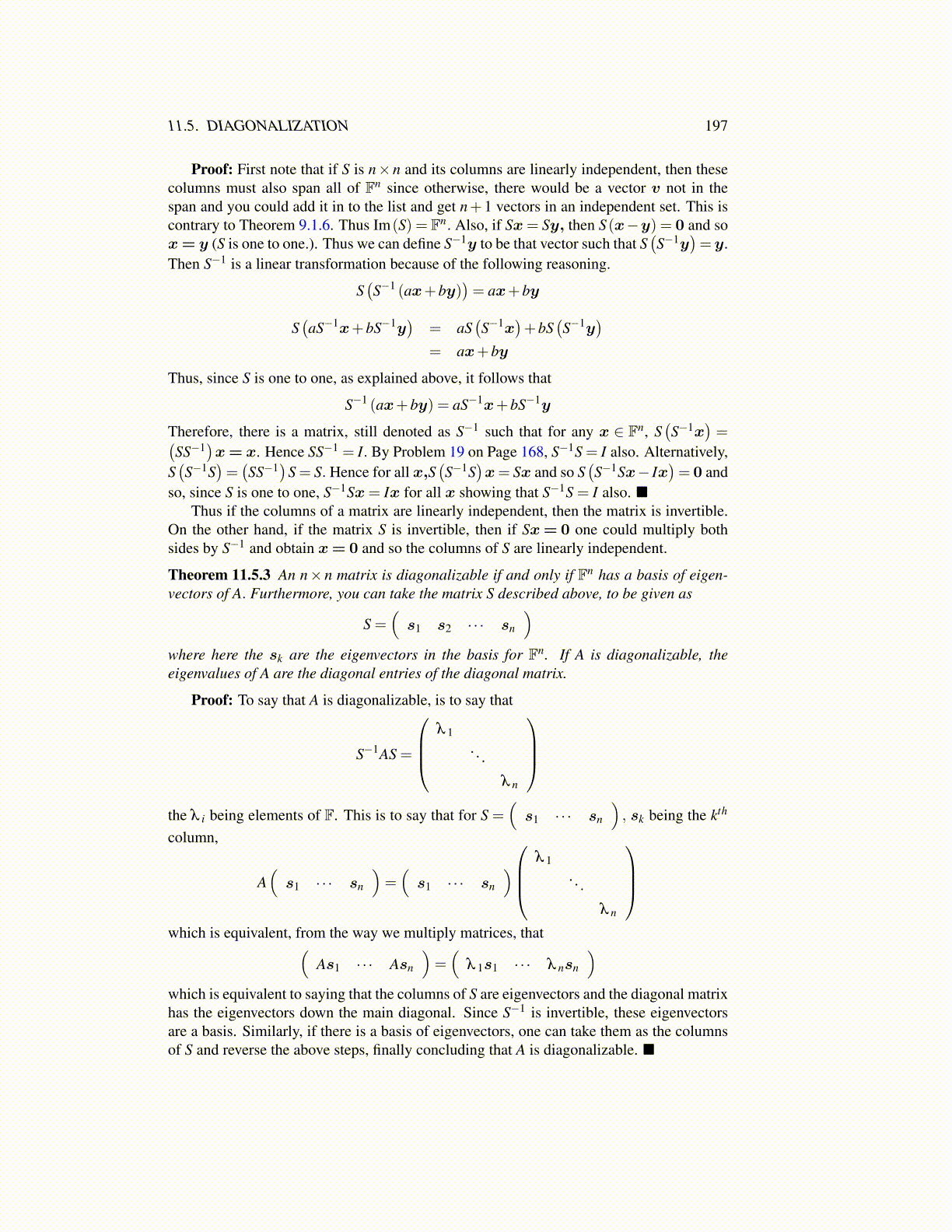
11.5. DIAGONALIZATION 197
Proof: First note that if S is n×n and its columns are linearly independent, then thesecolumns must also span all of Fn since otherwise, there would be a vector v not in thespan and you could add it in to the list and get n+1 vectors in an independent set. This iscontrary to Theorem 9.1.6. Thus Im(S) = Fn. Also, if Sx= Sy, then S (x−y) = 0 and sox= y (S is one to one.). Thus we can define S−1y to be that vector such that S
(S−1y
)= y.
Then S−1 is a linear transformation because of the following reasoning.
S(S−1 (ax+by)
)= ax+by
S(aS−1x+bS−1y
)= aS
(S−1x
)+bS
(S−1y
)= ax+by
Thus, since S is one to one, as explained above, it follows that
S−1 (ax+by) = aS−1x+bS−1y
Therefore, there is a matrix, still denoted as S−1 such that for any x ∈ Fn, S(S−1x
)=(
SS−1)x= x. Hence SS−1 = I. By Problem 19 on Page 168, S−1S = I also. Alternatively,
S(S−1S
)=(SS−1
)S = S. Hence for all x,S
(S−1S
)x= Sx and so S
(S−1Sx− Ix
)= 0 and
so, since S is one to one, S−1Sx= Ix for all x showing that S−1S = I also. ■Thus if the columns of a matrix are linearly independent, then the matrix is invertible.
On the other hand, if the matrix S is invertible, then if Sx= 0 one could multiply bothsides by S−1 and obtain x= 0 and so the columns of S are linearly independent.
Theorem 11.5.3 An n× n matrix is diagonalizable if and only if Fn has a basis of eigen-vectors of A. Furthermore, you can take the matrix S described above, to be given as
S =(
s1 s2 · · · sn
)where here the sk are the eigenvectors in the basis for Fn. If A is diagonalizable, theeigenvalues of A are the diagonal entries of the diagonal matrix.
Proof: To say that A is diagonalizable, is to say that
S−1AS =
λ 1
. . .
λ n
the λ i being elements of F. This is to say that for S =
(s1 · · · sn
), sk being the kth
column,
A(
s1 · · · sn
)=(
s1 · · · sn
)λ 1
. . .
λ n
which is equivalent, from the way we multiply matrices, that(
As1 · · · Asn
)=(
λ 1s1 · · · λ nsn
)which is equivalent to saying that the columns of S are eigenvectors and the diagonal matrixhas the eigenvectors down the main diagonal. Since S−1 is invertible, these eigenvectorsare a basis. Similarly, if there is a basis of eigenvectors, one can take them as the columnsof S and reverse the above steps, finally concluding that A is diagonalizable. ■